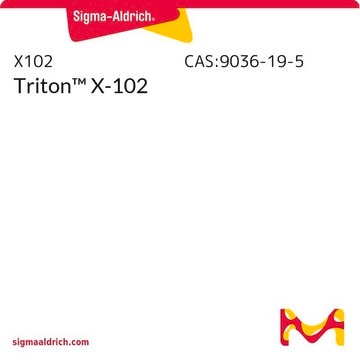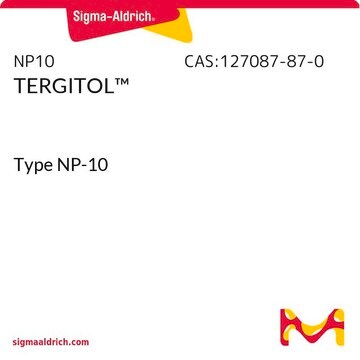X165
Triton™ X-165 solution
Non-ionic, CMC-0.43 mM, suitable for electrophoresis, cloud point >100 °C
Synonym(s):
Ethoxylated octylphenol, Octylphenol ethoxylate, Polyethylene glycol mono(octylphenyl) ether
About This Item
Recommended Products
Quality Level
description
non-ionic
mol wt
911 g/mol
technique(s)
electrophoresis: suitable
protein quantification: suitable
CMC
0.43 mM
transition temp
cloud point >100 °C
HLB
15.5
SMILES string
O(CCOc1ccc(cc1)C(CC(C)(C)C)(C)C)CCO
InChI
1S/C18H30O3/c1-17(2,3)14-18(4,5)15-6-8-16(9-7-15)21-13-12-20-11-10-19/h6-9,19H,10-14H2,1-5H3
InChI key
LBCZOTMMGHGTPH-UHFFFAOYSA-N
Looking for similar products? Visit Product Comparison Guide
General description
Application
- determining its effect on the stability of the multi-walled carbon nanotubes (MWNT) suspension in isopropyl alcohol
- studying its surface tension-dependent toxicity on the green peach aphid, Myzus persicae to determine the mechanism of surfactant action
- paints and coatings, agrochemicals, fiber lubricants, emulsion polymerization
Features and Benefits
- Excellent steric and freeze/thaw stabilizer
- Excellent for aromatic, chlorinated, and other compounds that are difficult to emulsify
- Offers good solubility in the presence of salts or electrolytes and caustic solutions
- Effective at high temperatures
- Compatible with anionic, cationic, and other nonionic surfactants
Legal Information
signalword
Danger
hcodes
Hazard Classifications
Acute Tox. 4 Oral - Aquatic Acute 1 - Aquatic Chronic 1 - Eye Dam. 1 - Skin Irrit. 2
Storage Class
10 - Combustible liquids
wgk_germany
WGK 3
ppe
Eyeshields, Faceshields, Gloves, type ABEK (EN14387) respirator filter
Choose from one of the most recent versions:
Already Own This Product?
Find documentation for the products that you have recently purchased in the Document Library.
Customers Also Viewed
Our team of scientists has experience in all areas of research including Life Science, Material Science, Chemical Synthesis, Chromatography, Analytical and many others.
Contact Technical Service









